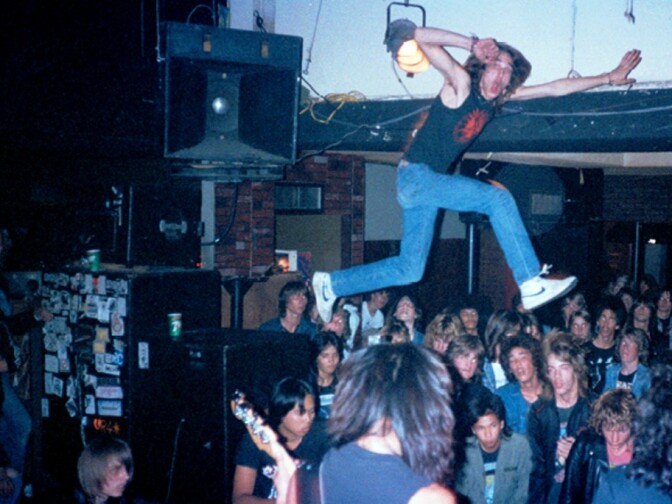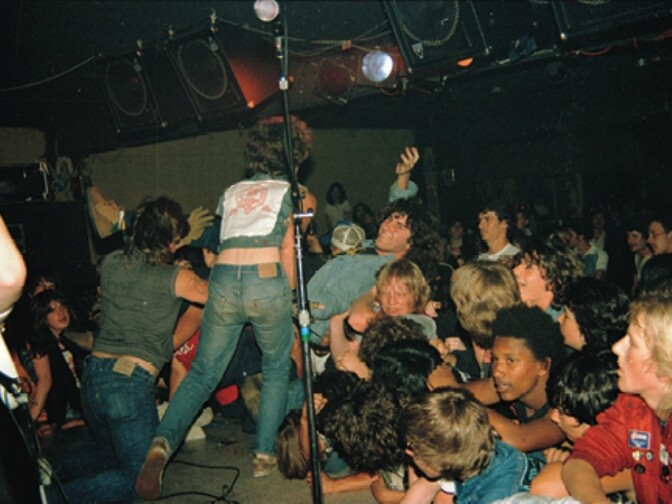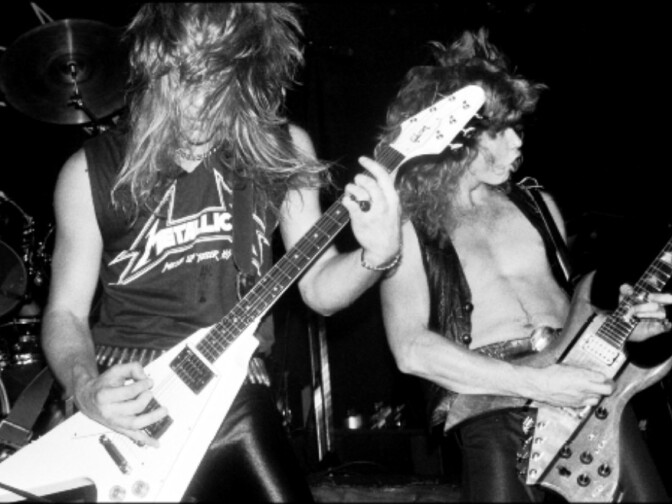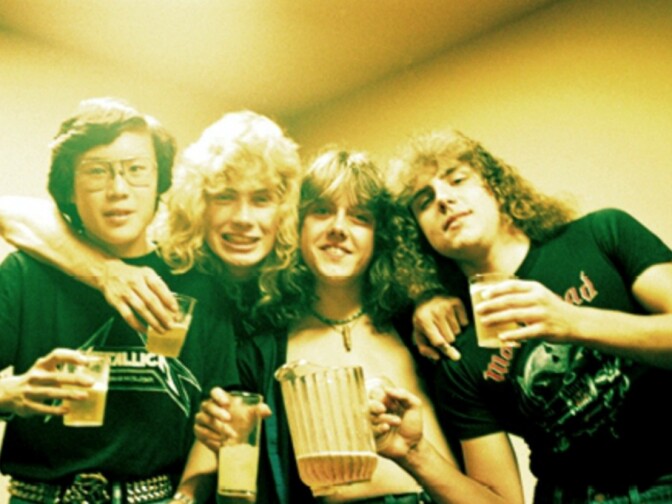With our free press under threat and federal funding for public media gone, your support matters more than ever. Help keep the LAist newsroom strong, become a monthly member or increase your support today.
'Murder in the Front Row' photo book goes inside '80s Bay Area thrash metal shows by Metallica, Slayer, others
The Grammy Award-winning heavy metal band Metallica recently celebrated its 30th anniversary, and while the band got its start in Los Angeles, it was the Bay Area’s “metalheads” who catapulted it and other metal bands to stardom.
Those bruising days are now chronicled in the book “Murder in the Front Row,” a collection of photographs that captures the mayhem onstage and off.
Some bands think you actually have to move to L.A. to make it big. But just months after forming in 1981, Metallica realized it had to move out.
“L.A. just didn’t treat us well,” remembers singer-guitarist James Hetfield in a VH1 documentary about the rise of ‘80s thrash metal.
At the time, the rock L.A. scene was dominated by Spandex-clad glam rockers like Motley Crue and Ratt — bands who seemed more interested in makeup than metal.
“We’d be onstage and all these people would be at the bar fluffing their hair," says Hetfield. "And that’s not what music was to us. We’re gonna play louder, we’re gonna play faster, we want some attention."
The band got it in San Francisco, among a small army of heavy metal loyalists including high school headbanger and photography enthusiast Brian Lew, who was among a hundred or so kids who witnessed the band’s San Francisco debut in the fall of 1982. The band was a last-minute fill-in for another L.A. band that dropped out.
“They sounded more European than most of the other bands we’d heard from the States,” says Lew.
“They played fast. And I remember my friends and I just being floored.”
The band was still a couple years away from cutting its first record, but word was getting around thanks to a six-song song demo tape dubbed “No Life 'til Leather.” Lew befriended the band, and when Metallica returned the following month to play a show at the Old Waldorf in San Francisco, he returned with his 35 mm camera.
He also talked the band into recording the show on a boombox (the recording is now available for free download at Metallica.com). This time the crowd was bigger — and rowdier.
James Hetfield even dedicated the band’s “ode to headbanger song” "Metal Militia" to Lew, who happened to be celebrating his 19th birthday. "Murder in the Front Row" includes a picture of Lew and members of Metallica (all under age at the time) swilling beer backstage.
“It wasn’t like we were on assignment to shoot photos of this band,” recalls Lew. “We were just hanging out, and Harald and I just happened to be the dorks who had the cameras.”
Lew is referring to co-author Harald Oimoen, another teenager who also started showing up with his 35 mm camera.
“And, um, I tended to drink a little bit and consume various things at the shows," says Oimoen, "so I wanted something to remember the concerts by, and I figured that was a great way to do it!"
The pair would go on to document rehearsals, live gigs and all the mayhem in between.
“There’s not a lot, if any, photo books of the early days of a metal scene,” explains Lew. “Seems like every punk scene is documented, but metal kids? No one had a camera — and if they did, it was just a cheap Instamatic.”
Lew and Oimoen found themselves in more than just a scene. They were on the front line of a music revolution. Bay Area thrash metal bands were stripping down the windy arrangements of hard rock dinosaurs like Deep Purple and Led Zeppelin and distilling it into something faster, louder and meaner.
In 1983, Metallica relocated to the Bay Area for good. It also harvested two new members from other Bay Area bands: guitarist Kirk Hammit and bass player Cliff Burton.
When Burton auditioned for the band at its home in the city of El Cerrito, Lew was there shooting away, capturing the first portraits of Metallica with its soon-to-be legendary new bassist.
Other L.A. bands, including Megadeth and Slayer, would also make regular trips north to test their mettle in front of the Bay Area’s metal horde.
“Slayer, we gave them a hard time about their makeup,” says Oimoen. “[They used to wear] this black stuff underneath their eyes. Made ‘em look like football players. We told them how silly it was. After that, they didn’t wear it because they realized how kinda poseur-ish that was.”
Slayer and Metallica may be the best known acts featured in "Murder in the Front Row," but another is more infamous: Exodus. The notorious band from the Oakland area has its blood-soaked lyrics etched into the photo book’s spine:
“Murder in the front row / Crowd begins to bang / And there's blood upon the stage...”
“We were kind of being murdered in the front row while we took the photos! People landing on us, stage diving,” Oimoen says, explaining his name choice. “It just summed up the whole vibe of the scene back then.”
Exodus songs like “No Love,” “Strike of the Beast” and “A Lesson in Violence” were battle cries, inciting headbangers to slam dance and stage dive, rituals that until then were unheard of at a metal show.
“You don’t see many pictures shot from right against the stage, because it was just mayhem,” says Lew.
Two notorious stage divers dubbed the “Slay Team” would hurl themselves from speaker cabinets and sprint boot-first from the stage.
“Toby ‘Rage’ [Staniford] was pretty much this fearless stage diver. There’s a couple pictures of him in the book,” says Oimoen.
“There’s one, it’s a Slayer show in Sacramento, and there were these huge PA columns on the opposite side of the stage, and he just did this most amazing swan dive. He’s looking right at the camera.”
By the mid-1980s it was virtually impossible to shoot thrash metal shows except from a safe distance. At one show in Sacramento, Oimoen was shooting the band Possessed from what he figured was a safe vantage point: between the stage and a security barrier.
“I mean, the crowd was completely nuts,” recalls Oimoen.
Nuttier than usual. As the band roared away, Oimoen saw the barrier give way from the corner of his eye. He leapt for the stage, but it was too late.
“And I didn’t get my leg out in time, and I ended up having the weight of the whole crowd pinning my leg between the barricade and the stage," says Oimoen. "It was like a big vise." The band stopped playing and pulled him to safety, but the rock photographer ended up with a broken leg.
Oimoen would keep on shooting metal shows, but with a little less zeal.
Brian Lew drifted away from the scene, disenchanted by the increasing violence and dispirited after Metallica bassist and friend Cliff Burton was killed in a tour bus crash in 1986.
“It stopped being fun,” he said. However, Lew has since returned to the Bay Area metal scene and even writes about it on his blog Umlaut.
But “Murder in the Front Row” wipes away much of that for Lew and Oimoen.
“Hopefully, the book shows just the camaraderie and the friendship between the bands and the fans,” says Oimoen.
For them and for many of the bands and fans who were there, it’s like a celebratory yearbook from Heavy Metal High.
“Everybody is smiling, and I think that’s kind of the theme. This is just a bunch of kids having fun, the kids on stage and the kids off stage,” adds Lew.
“One big drunken, happy dysfunctional family, y’know?!” laughs Oimoen.
Or to paraphrase a Metallica song: "We are one, fighting for one cause, joining together to take on the world, with our heavy metal."














